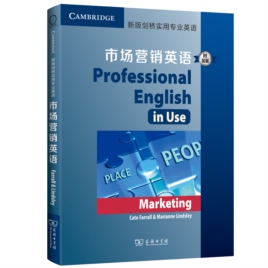显示全部编辑推荐
一本可以迅速学习营销英语的专业英语书。
这是一本既可做自学材料,也可做课堂学习的专业英语书。它能帮助你迅速熟悉和学习在商务环境下有关市场营销英语的词汇和表达。
丛书简介:
“新版剑桥实用专业英语系列”是从剑桥大学出版社引进的一套英文影印丛书,共六种,分别是《医学英语》《法律英语》《工程英语》《市场营销英语》《管理英语》和《金融财务英语》。

定价:¥68.00
一本可以迅速学习营销英语的专业英语书。
这是一本既可做自学材料,也可做课堂学习的专业英语书。它能帮助你迅速熟悉和学习在商务环境下有关市场营销英语的词汇和表达。
丛书简介:
“新版剑桥实用专业英语系列”是从剑桥大学出版社引进的一套英文影印丛书,共六种,分别是《医学英语》《法律英语》《工程英语》《市场营销英语》《管理英语》和《金融财务英语》。
《新版剑桥实用专业英语:市场营销英语(附答案)》内容涵盖市场营销理论、市场调研、产品、定位与品牌建立、人员、价格、渠道、促销、包装以及公共关系等商务主题。每个单元都有关键词和表达方式的详解以及练习,供学习者检查和进一步理解所学到的知识。每个单元还设计了“请你参与”部分,为学习者提供情境模拟的机会。本书最后附有练习题答案和索引,供读者自我检测和深入学习。
Introduction
Who is this book for?
Professional English in Use Marketing presents the vocabulary and expressions required to speak about marketing and related fields. It is designed to help those who work in marketing and need to use English. It will also help marketing students preparing for their first contacts with English speakers or studying for exams in English. The level of the book is intermediate to upper-intermediate.
This book assumes you know, or are in the process of learning from your marketing course, common marketing and communication concepts (such as the marketing mix and targeting). Our focus is on the words that are often used by professionals when talking and writing about marketing (such as core target and focus groups) and on English words which are given a special meaning in marketing (such as buzz and loyalty). Every unit uses authentic sources, including marketing forums, company websites, articles from the trade press, marketing blogs, marketing presentations, and case studies.
You can use the book on your own for self-study, or with a teacher in the classroom, oneto- one or in groups.
How is the book organized?
The book has 50 two-page thematic units. The units are divided into ten sections which cover topics such as Product, Price and Place. The first section, Marketing basics, introduces essential marketing vocabulary and concepts which you will need to tackle the more specialized units later in the book.
The left-hand page of each unit explains new words and expressions and shows how the vocabulary is used in real contexts. The right-hand page allows you to check and develop your understanding of the new language and how it is used, through a series of exercises. There is cross-referencing between units to help you develop your vocabulary.
There are twelve appendices, covering examples of confusing words, preparing a marketing plan, talking about numbers, describing brand values, market segments, indirect distribution methods, advertising techniques, TV and radio dayparts and programmes, types of out-of-home advertising, types of magazine, a newspaper rate card, and mailshot items.
There is an answer key at the back of the book. Most of the exercises have questions with only one correct answer. But some of the exercises, including the Over to you activities at the end of each unit (see opposite), are designed for writing and / or discussion.
There is also an index, which lists all the new words and expressions presented in the book and gives the unit numbers where they appear. It also indicates how the terms are pronounced.
The left-hand page
This page presents the key vocabulary in bold typeface for each theme or skills area. The language is introduced in a series of short texts, dialogues, diagrams and tables. Many vocabulary items are illustrated. Each unit has sections indicated by a letter – usually A, B and C – and a clear title.
In addition to vocabulary explanations, this page includes information about typical collocations (word combinations) and register (formal and informal language).
There are also notes on language points, for example where a particular grammatical form is associated with a word, or where the same word may have different uses.
The right-hand page
The exercises on the right-hand page allow you to check your understanding and give you practice in using the words and expressions presented on the left-hand page. There are a variety of exercises including crosswords, short texts, gap fills, matching exercises, and tables to complete.
‘Over to you’ sections
An important feature of Professional English in Use Marketing is the Over to you section at the end of each unit. This is your opportunity to put into practice the words and expressions in the unit by relating it to your professional situation, studies or opinions.
How to use the book for self-study
We suggest all learners start with the Marketing basics section. Learners can then work systematically through the book or pick topics that interest them from the contents page.
Read through the texts on the left-hand page. If you meet words which you consider important and which are not explained in the text, look at the index to see if they are explained in another unit. Do the exercises on the right-hand page and check your answers in the key. If you find you have made mistakes, go back to the left-hand page use as many new words as possible. You should present your ideas out loud and ideally record yourself. The index gives help with pronunciation.
How to use the book in a classroom
Teachers can use this book as a framework for an ‘English for Marketing’ course or to supplement more general course books. The illustrations can often be used as a warm-up activity or as a talking point during the class. Sometimes, the left-hand page may be used as the basis for a presentation, either by the teacher or the learners. Learners can do the exercises individually or in small groups. They can compare answers in the groups or as a whole class feedback session. In the classroom, the Over to you sections can be used as a starting point for role plays, discussions and presentation activities, or adapted to out-of-class projects.
We hope you enjoy using this book.
京ICP备05007371号|京ICP证150832号|![]() 京公网安备 11010102001884号 版权所有 2004 商务印书馆
京公网安备 11010102001884号 版权所有 2004 商务印书馆
地址: 北京王府井大街36号|邮编:100710|E-mail: bainianziyuan@cp.com.cn
产品隐私权声明 本公司法律顾问: 大成律师事务所曾波律师